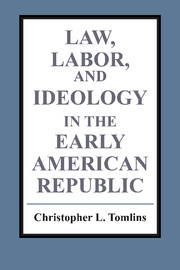Book contents
- Frontmatter
- Contents
- Preface and acknowledgments
- Prologue: two moments of the republic
- PART 1 LAW AND THE FACTS OF AMERICAN LIFE
- PART 2 LAW, LABOR, AND STATE
- PART 3 LAW, AUTHORITY, AND THE EMPLOYMENT RELATIONSHIP
- Introduction: the nomenclature of power
- 7 The law of master and servant
- 8 Master and servant in republican America
- An interlude: on law and economy
- PART 4 THE NEW INDUSTRIAL ORDER
- Epilogue: “free Ameriky”
- Index
8 - Master and servant in republican America
Published online by Cambridge University Press: 05 August 2012
- Frontmatter
- Contents
- Preface and acknowledgments
- Prologue: two moments of the republic
- PART 1 LAW AND THE FACTS OF AMERICAN LIFE
- PART 2 LAW, LABOR, AND STATE
- PART 3 LAW, AUTHORITY, AND THE EMPLOYMENT RELATIONSHIP
- Introduction: the nomenclature of power
- 7 The law of master and servant
- 8 Master and servant in republican America
- An interlude: on law and economy
- PART 4 THE NEW INDUSTRIAL ORDER
- Epilogue: “free Ameriky”
- Index
Summary
“When I use a word,” Humpty Dumpty said, in rather a scornful tone, “it means just what I choose it to mean – neither more nor less.”
“The question is,” said Alice, “whether you can make words mean so many different things.”
“The question is,” said Humpty Dumpty, “which is to be master – that's all.”
Lewis Carroll,Through the Looking Glass, And What Alice Found ThereDuring the first half of the nineteenth century, the number of Americans employed by others, in agricultural and nonagricultural pursuits, increased markedly. Nonagricultural employment grew particularly rapidly. Off the farm, between 1820 and 1850 the number of persons working rose from approximately 800,000 to slightly less than 3 million. Over the same period the number of agricultural workers increased at a lower rate, from slightly over 2 million in 1820 to almost 5 million in 1850. By midcentury, on and off the farm, it seems likely that the proportion of productively engaged Americans employed by others – about one-third in 1820 – had increased to about one-half. In the Eastern industrializing states (Massachusetts, Pennsylvania, New York) the proportion was probably closer to three-fourths.
- Type
- Chapter
- Information
- Law, Labor, and Ideology in the Early American Republic , pp. 259 - 293Publisher: Cambridge University PressPrint publication year: 1993



